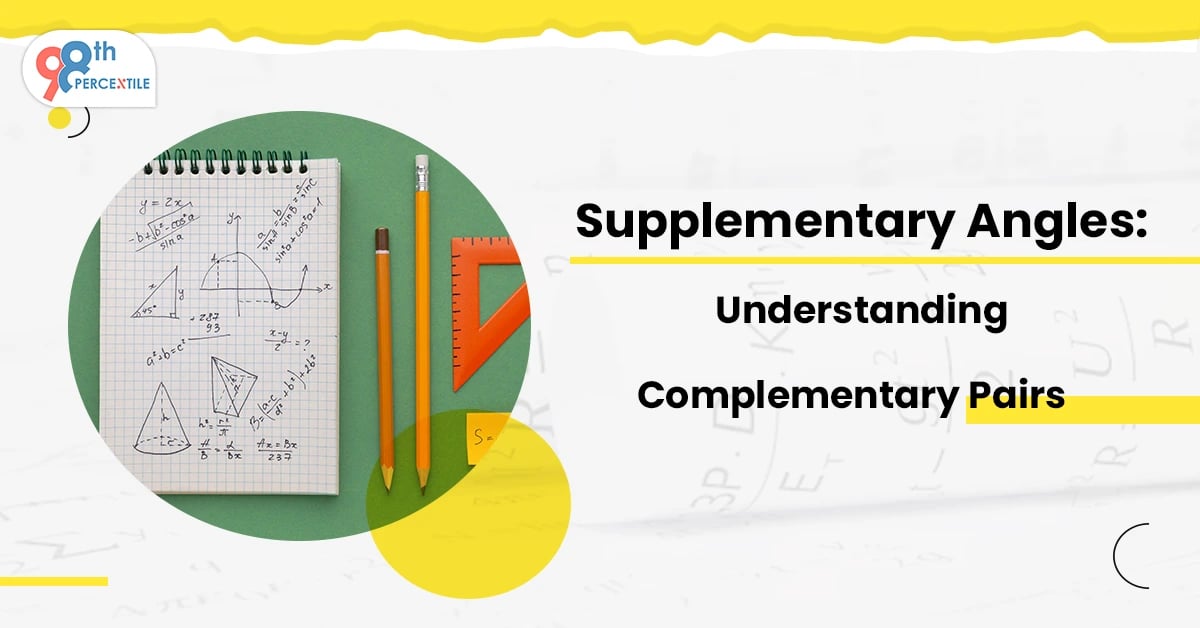Angles, the basic building blocks of geometry, are essential for comprehending the relationships between geometric figures. Among the numerous types of angles, supplementary angles stand out for their unique features and applications. In this comprehensive book, we will delve into the mysteries of supplementary angles, including their definition, attributes, and the fascinating realm of complementary pairs.
Get Your FREE Math Worksheets Now!
Defining Supplementary Angle
To begin our investigation of additional angles, we must first understand their fundamental description. Supplementary angles are pairs of angles with angle measurements that sum up to 180 degrees. In layman's words, when two supplementary angles are placed side by side, they produce a straight line, also known as a straight angle.
Mathematically, if angles A and B are supplementary, their sum can be expressed as ∠A+∠B=180˚
This relationship opens the door to a myriad of possibilities for understanding and manipulating angles within geometric shapes.
Properties of Supplementary Angles
Supplementary angles exhibit several interesting properties that make them invalu Supplementary angles have a fascinating interaction with another type of angle: complimentary angles. Complementary angles are two angles that sum up to 180 degrees. The intersection of supplementary and complimentary angles produces complementary pairs, providing a better grasp of angular relationships inside geometric shapes. able in geometry:
-
Linear Pairs: As previously stated, additional angles produce a straight line when combined. This distinguishing feature leads to the concept of linear pairs. When two angles are supplementary and contiguous (have a common vertex and side), they constitute a linear pair. This characteristic is critical for solving geometry problems that include intersecting lines and angles.
-
Multiple Pairs: A single angle can be supplementary to more than one angle, and vice versa. This flexibility allows for diverse combinations within geometric figures, enabling mathematicians and students to analyze and manipulate angles in intricate shapes.
-
Complementary Pairs: Supplementary angles also have a fascinating relationship with another category of angles—complementary angles. The pair of angles whose angle measures add up to 180 degrees are known as Complementary angles. The connection between supplementary and complementary angles creates complementary pairs, offering a deeper understanding of angular relationships within geometric configurations.
Recognizing Supplementary Pairs
Recognizing supplementary angles is a valuable skill in geometry. Several methods can be employed to identify supplementary pairs in geometric figures:
-
Angle Measurement: The most easy way is to measure the angles with a protractor. If the sum of the angle measurements equals 180 degrees, the angles are supplementary. This method is successful, although it might be time-consuming for complex figures.
-
Vertical Angles: In many cases, vertical angles can be supplementary. Vertical angles are formed when two lines intersect, and their opposite angles are equal. If you can identify a pair of vertical angles in a figure, there's a good chance they are supplementary.
-
Algebraic Equations: For more difficult issues, algebraic equations can be used. Assign variables to the unknown angles, create equations using the supplementary connection, then solve for the angles' measurements. This strategy is very beneficial for dealing with variables and unknowns in geometric issues.
-
Complementary Pairs: The interaction of supplemental and complementary angles adds another degree of complexity to the study of angles. Complementary pairs, as the name implies, involve one angle supplementary to another, resulting in a combined measure of 90°. Let's look at how these couples function together.
-
Complementary and Supplementary Relationships: Consider a pair of complementary angles, angles C and D, where ∠C+∠D=90˚. If we introduce another angle, E, such that ∠D+∠E=90˚, then ∠C+∠E forms a supplementary pair, as 90˚+90˚=180˚. This demonstrates the seamless connection between complementary and supplementary angles.
-
Application in Problem-Solving: When faced with complex geometric problems, understanding complementary pairs can simplify the analysis. By recognizing complementary relationships, mathematicians can identify supplementary angles and vice versa, streamlining the process of solving intricate geometric puzzles.
Actual Applications of Supplementary Angles
The significance of supplementary angles extends beyond the confines of mathematical abstraction. In the real world, these angles find practical applications in various fields:
-
Architectural Design: Architects frequently utilize angles and geometric principles in designing structures. Understanding supplementary angles is crucial for creating aesthetically pleasing and structurally sound buildings.
-
Surveying and Navigation: Surveyors and navigators rely on angles for measurements and directions. Supplementary angles play a role in calculating bearings and ensuring accurate alignment.
-
Physics and Engineering: In physics and engineering, angles are integral to the analysis of forces, trajectories, and structural stability. Supplementary angles aid in solving problems related to equilibrium and vector analysis.
In a nutshell, additional angles provide an enthralling voyage into the world of geometry, revealing the complexities of angular relationships inside geometric forms. As we've seen, these angles have distinct features, create linear pairs, and make intriguing connections with complementary angles. Mastering the notion of extra angles improves mathematical skills and opens the door to practical applications in a variety of professions.
As you explore the universe of angles, keep in mind that studying supplementary angles is more than just a mathematical exercise; it is also a gateway to comprehending the beautiful interaction of shapes and lines in our surroundings. So, accept the challenge, explore the possibilities, and discover the secrets of additional angles to improve your geometric skills.

 Students/Staff
Students/Staff Parents
Parents ElevatEd
ElevatEd














